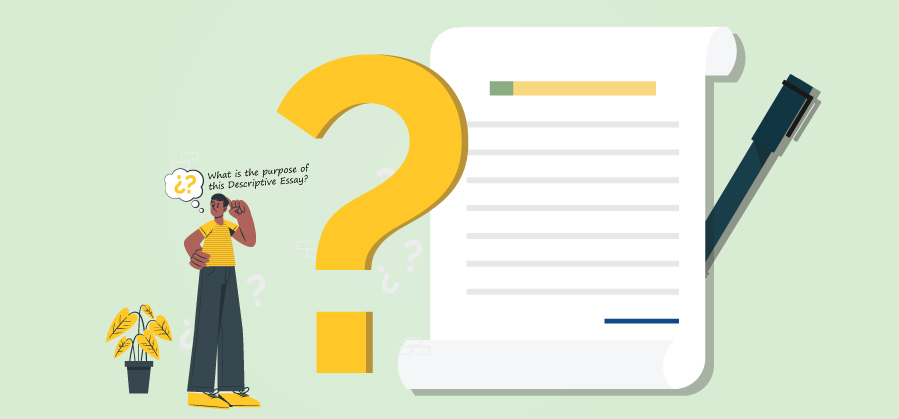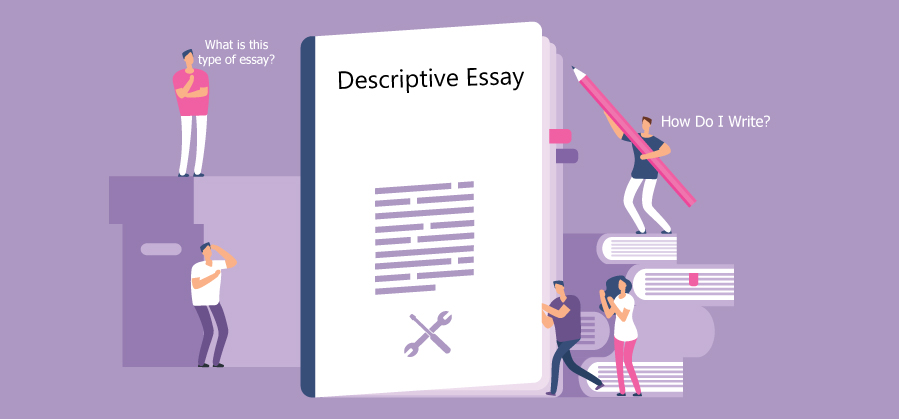- MyAssignmentHelpAu
- 29 Nov 2021
A descriptive essay fully explains the issue and uses words to create a mental image for the reader.

It might be about anything, including an object, a location, a person, an emotion, a circumstance, or anything else. It may appear to be similar to writing a narrative essay, but it differs in giving several points of view.
It is utilized to improve pupils' analytical ability, beneficial in their future schooling and professional lives. As a result, it is frequently provided to high school and college students.
"It is the most expressive form of an essay," according to the definition of a descriptive essay This form of writing is intended to describe and explain anything in great detail, such as an event, a location, a person, or anything else."
This essay enhances the student's ability to construct an image by appealing to the reader's senses. Hearing, touch, taste, sight, and smell are the five human senses.
What is the Purpose of a Descriptive Essay?

A descriptive essay describes anything, such as a person, an item, a location, or a circumstance. Descriptive speeches or writings provide a vivid image of the essay topic for the audience. To assist the reader grasp what the essay is about, the writer should utilize explicit language.
It does not need persuasion or the presentation of facts to substantiate a point, as an argumentative essay requires. Instead, it strives to highlight all of the crucial facts about the selected subject for the reader to grasp it quickly. Reach out to expert essay help to explore the essentials of the essay further.
A Descriptive Essay's Components
It is made up of five essential elements:
• Sensory Details
It entails stirring the readers' emotions and establishing a connection with them. They stimulate the reader's senses of sight, touch, smell, and taste by painting a picture of the subject.
Figurative Expressions
One of the most important aspects of a descriptive essay is the use of figurative language. The subject's character profile is created by metaphors, similes, adjectives, and adverbs, among other things. This sketch allows readers to experience what the writer thought about the subject and to envision it.
• Theme central
The major subject forms and leads the essay's material and aids in the organization of the specifics. It should be well-defined and narrowly focused on a particular goal.
• Precise Language
The impact of your essay is determined by the sort of language you employ. The essay's core idea and the goal should be emphasized throughout the wording. As a result, avoid using confusing or imprecise language.
• Organize your Thoughts
This essay has to have a well-organized framework. In addition, the chronology, physical location, and order all have a role.
What Is a Descriptive Essay and How Do I Write One?

Topic selection, outline creation, concept organization, and inclusion of important material all go into writing an excellent descriptive essay.
The method of descriptive writing is outlined here.
1. Pick a topic
It is critical to select a suitable essay topic. The essay topic should be appealing enough to entice the reader to stick with you for the duration of the essay.
2. Make a rough outline
With the aid of the Essay Writing Service, create a descriptive essay outline to organize your facts in a logical order. It will aid in the organization of your essay and serve as a reminder to incorporate all sensory aspects. Get essay help today to know more.
3. Write a Descriptive Essay about yourself Introduction
An introduction is given at the start of the essay. It presents the primary issue and contains a strong viewpoint that provides the essay with its initial impression. The introduction provides a high-level summary of the essay's topic.
4. Write an informative thesis statement.
The thesis statement defines the scope and aim of the descriptive essay. It's a short topic line that has to be concise and exact. Imaginatively write the sentence using descriptive terms.
The reader will be drawn to the body of your essay if your thesis statement creates a sense of mystery.
5. Write your body paragraphs
The body paragraphs complement the Introduction and purpose, and they follow the thesis statement's direction. Make the first sentence of each section a topic sentence, then back it up with facts.
The next stage is to use transition words to connect your paragraphs. Conjunctions make up the majority of the transition words in this article. Use conjunctions that are relevant to your writing.
In the case of experience and recollections, appropriately organize your paragraphs in an orderly manner.
6. Finish your descriptive essay with a strong conclusion.
The conclusion is the final section of your essay, and it is your last opportunity to impress the reader. It summarises the article and suggests a path ahead.
You can use terms like "to conclude with," "in conclusion," and "finally" to signal that the essay is coming to a close. Your conclusion on a research issue will restate the thesis statement and explain the findings.
The essay's closing phrase should summarise the writer's purpose for writing the article and leave a lasting impression.
Topics for Descriptive Essays

Your topic should include solid supporting arguments that describe the issue, whether you're writing about a person or a place.
Choosing an interesting topic will pique the reader's interest and keep them reading until the end. MyAssignmentHelpAU has compiled a fantastic selection of descriptive essay ideas for you.
Descriptive Essay about a Location
- Write a description of the Lincoln Castle in your own words.
- How would you describe the dwelling of your dreams?
- Write a description of your visit to Safari Park last week.
- Create a scenario for your coworkers in a conference room.
- Describe your vision of Niagara Falls.
An Essay on a Memory is a descriptive essay on a memory.
- Describe one of your earliest childhood recollections.
- Can you recall your happiest memory?
- How did you celebrate the birthday of your best friend?
- When I first saw the apple seed, I was ecstatic.
- The first time I traveled outside of the United States
Describe a Person in a Descriptive Essay
- Show Nelson Mandela as a positive role model.
- Describe how you envision aliens to be.
- Create a character sketch for a character in Hamlet.
- Describe a member of your family.
- In the lobby, I encountered a stranger.
Descriptive Essay about an Object
- My fortunate watch
- My favorite badminton racket
- The flask I shattered
- The Silk Road
- The item you've always wanted to acquire
Example of a Descriptive Essay

Before writing their essay, the writer must read several Descriptive Essays Writing Help. An essay sample may assist you in demonstrating, compiling, and logically organizing your essay.
The final goal of MyAssignmentHelpAU practice is to discover and understand several approaches for producing a powerful descriptive essay. We've included some fantastic examples below to assist you in understanding the process.
Vacation in the Summer
My family has always looked forward to escaping the sweltering summers in Florida. It's a huge relief to get out of the sweltering heat of July in Florida. Every summer, we go to our hometown in upstate New York via the yellow brick road. As we go through state after state, it becomes clear that the world is changing around us. We are already noticing changes in South Carolina. The trees look touchable, with soft, fluffy leaves that wave in the air, and the grass, rather than driving us away with mounds of invading fire ants, actually encourages us to share its space. Our eagerness grows as each state introduces fresh surroundings, and the home appears to be getting closer all the time. The most waking moments are when we leave the flatlands and enter a place where purple and turquoise hills suddenly surround us.
The environment in Virginia and Pennsylvania is spectacular, with towering cliffs and checkerboard farmlands. Home is now very close as we drop through the bends and winds of the northern United States: we are almost there. We've gone from wide-open flatlands to a tight, twisting road bordered by stone and tree-covered slopes. Around every bend, orange and black tiger lilies thrust themselves out toward the automobile, saying hello and flashing their strange black spots toward us as we pass by. The return voyage is nearly complete.
The sights become very familiar as we make our last descent into Pennsylvania into upstate New York. We are soon greeted by a sign that reads "Waverly, 18 kilometres" and familiar grazing cow fields. The bursting foliage appears to surround us and transport us over the hills like a natural carriage across the final stretch of Pennsylvania. Our entire family, including the smallest member, is aware that our vacation in New York will begin at this time. Our eldest son has joked that he can already "smell" Grandma's apple pie for years. After about fifteen minutes, we notice the smokestack from the nearby plant as we cross the Pennsylvania-New York border and become conscious of our surroundings as our car passes over the last crest. We arrive after a few turns. We've arrived at our destination; we've arrived at our house.
While looking through the example above, keep these principles in mind

- Title: Take note of how the clever title links to the article.
- The first paragraph establishes the scene: where the action occurred when it occurred, and to whom it happened. Take note of the descriptive terms.
- First body paragraph: Notice how the writer adds specifics, converting an experience into written words that allow the reader to picture the scene. Make a mental note of the descriptive information.
- The present tense is used in this article; on the other hand, most tales will be written in the past tense. Either tense has the potential to be useful.
Note the usage of details, particularly adjectives, in the second body paragraph. The writer employs metaphorical language (personification - flowers "waving hello"). - Third body paragraph: The writer continues to use visually descriptive words to appeal to the reader's senses. The simile "like a vehicle built by nature" is another example of figurative language.
- Imagery: Take note of how the writer uses sensory appeals to generate images for the reader (bold font).
- Conclusion: The writer alludes to a different sensation (smell) and uses words to signal the end ("final crest"). The essay comes to a solid conclusion.
Seek assistance of the experts
Seeking the assistance of the experts offers you a wonderful opportunity to explore the unending possibilities that the professionals have in store for you. From offering a state of the art essay to a plagiarism-free paper, the essays are exactly how your dreams are made of! Reach out to essay writing help to explore more.
